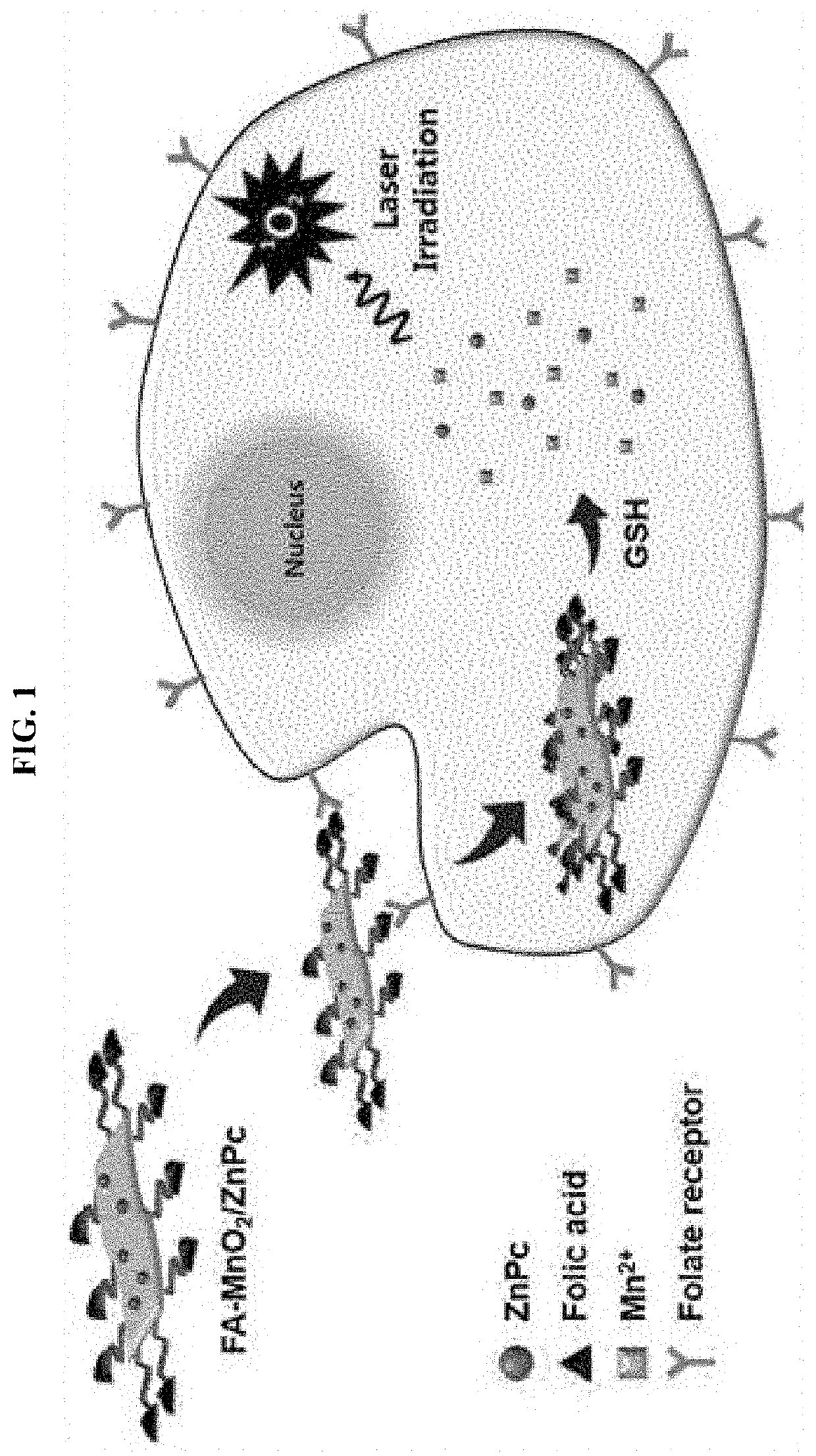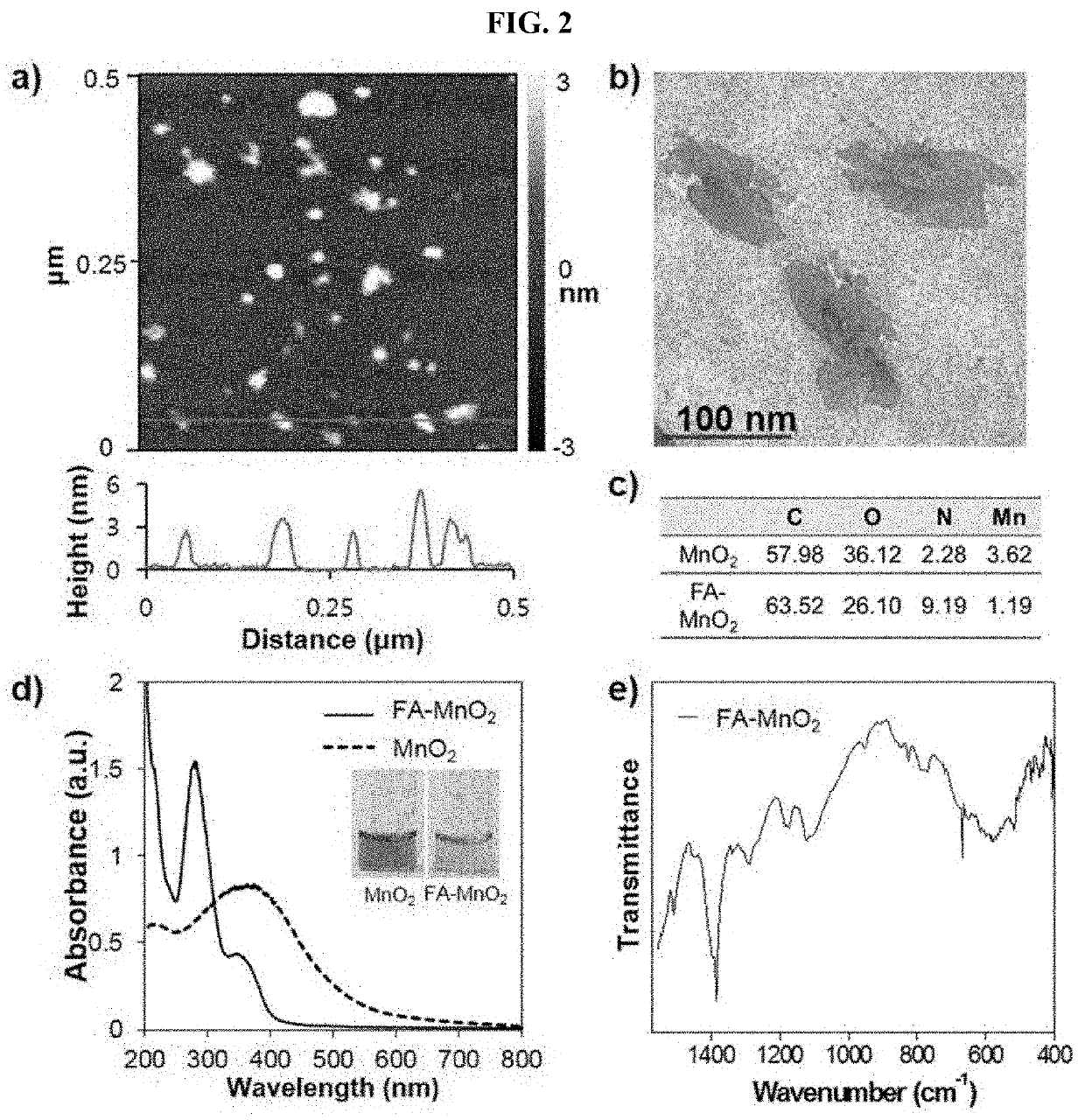Pharmaceutical composition for cancer treatment
a technology of pharmaceutical compositions and cancer, applied in the direction of drug compositions, heavy metal active ingredients, inorganic non-active ingredients, etc., can solve the problems of skin photosensitivity, target-to-background signal ratio, and kill normal eye cells, so as to inhibit the release of imprudent photosensitizer, increase solubility, and maintain stability
- Summary
- Abstract
- Description
- Claims
- Application Information
AI Technical Summary
Benefits of technology
Problems solved by technology
Method used
Image
Examples
example 1
1. Preparation of FA-MnO2 Nanosheet
[0135]Most of all, according to the method in the above section 1-3, MnO2 was synthesized by partially modifying the previously known procedure, and then, the prepared MnO2 nanosheet was characterized according to XPS, AFM, TEM and FTIR assays. Thereafter, FA was bonded to the MnO2 nanosheet. Characteristics of such fabricated FA-MnO2 nanosheet are shown in FIG. 2.
[0136]First, FA-MnO2 nanosheet having an average height of about 3 to 10 nm was identified through morphological images having a specific line profile obtained from the AFM and TEM images (see a) and b) of FIG. 2). Further, after binding FA to MnO2, it was demonstrated that elemental compositions of carbon and nitrogen were significantly increased by 63.5 and 9.19%, respectively. Further, it was identified that sharp UV-absorption peaks corresponding to FA are exhibited at 282 nm along with characteristic peaks at 370 nm due to MnO2 (see c) and d) of FIG. 2). Finally, FT-IR shows unique p...
experimental example
1. Identification of Degradation of MnO2 by GSH and ZnPc Separation by the Same
[0142]Glutathione (GSH) as a reducing agent abundant in cytoplasm may induce degradation of MnO2 to form Mn2+ cations. Therefore, in order to verify whether ZnPc can be easily separated from MnO2 nanosheets entered into a cell, whether or not ZnPc is easily separated from the FA-MnO2 / ZnPc complex prepared in Example 3 has been determined by means of experiments.
[0143]As a result, as shown in b) of FIG. 3, when adding
[0144]GSH to the FA-MnO2 / ZnPc solution, the eliminated fluorescence of ZnPc is gradually recovered, thus to demonstrate that degradation of the FA-MnO2 mediated by GSH enables release of ZnPc from the FA-MnO2 / ZnPc complex. On the other hand, under non-GHS condition and in a case of adding a protein such as bovine serum albumin (BSA) or FBS, it could be found that degradation of the FA-MnO2 / ZnPc complex is almost not induced.
[0145]Accordingly, it is expected that the FA-MnO2 / ZnPc complex may be...
PUM
| Property | Measurement | Unit |
|---|---|---|
| wavelength | aaaaa | aaaaa |
| wavelength ranges | aaaaa | aaaaa |
| emission wavelength | aaaaa | aaaaa |
Abstract
Description
Claims
Application Information
 Login to View More
Login to View More - R&D
- Intellectual Property
- Life Sciences
- Materials
- Tech Scout
- Unparalleled Data Quality
- Higher Quality Content
- 60% Fewer Hallucinations
Browse by: Latest US Patents, China's latest patents, Technical Efficacy Thesaurus, Application Domain, Technology Topic, Popular Technical Reports.
© 2025 PatSnap. All rights reserved.Legal|Privacy policy|Modern Slavery Act Transparency Statement|Sitemap|About US| Contact US: help@patsnap.com



